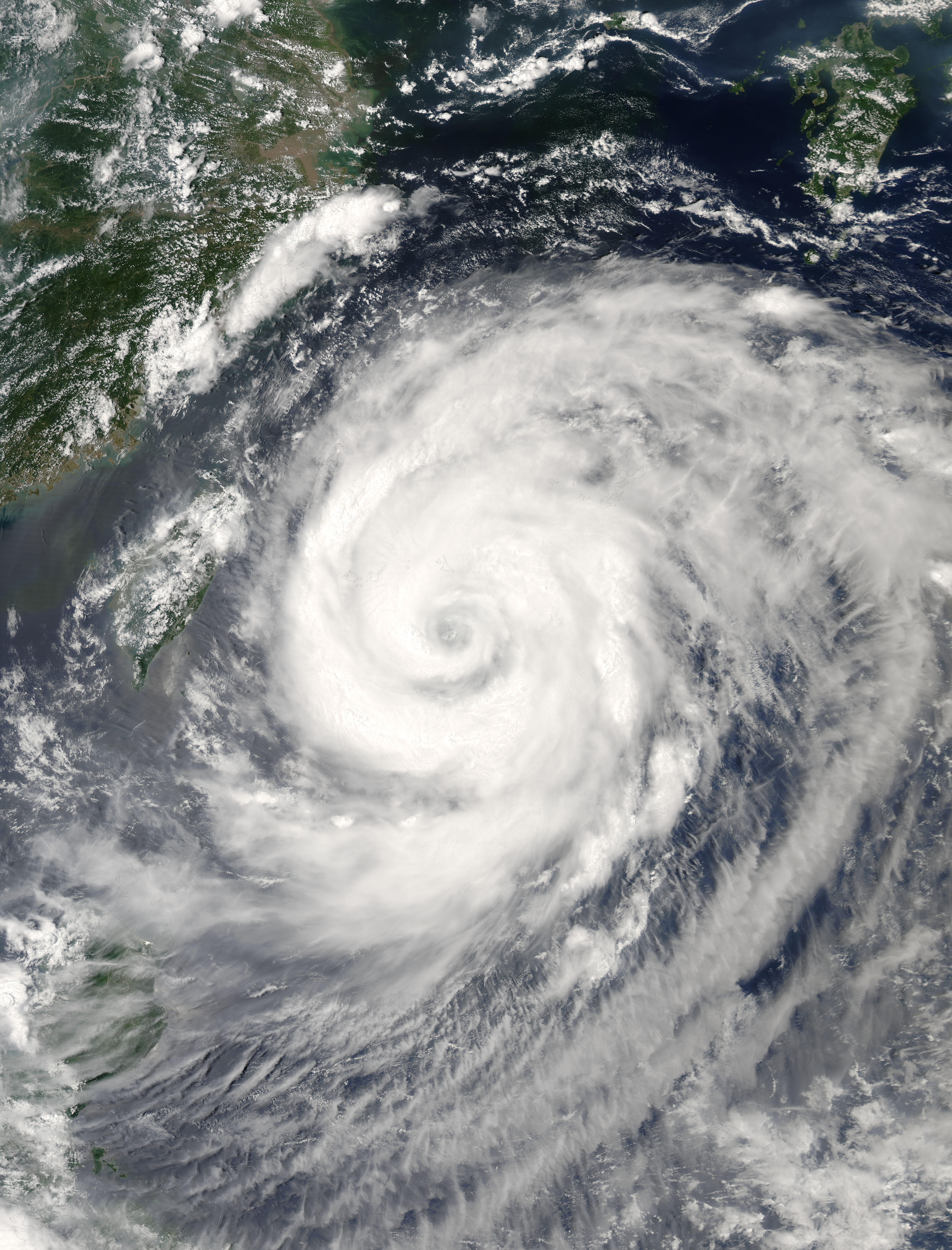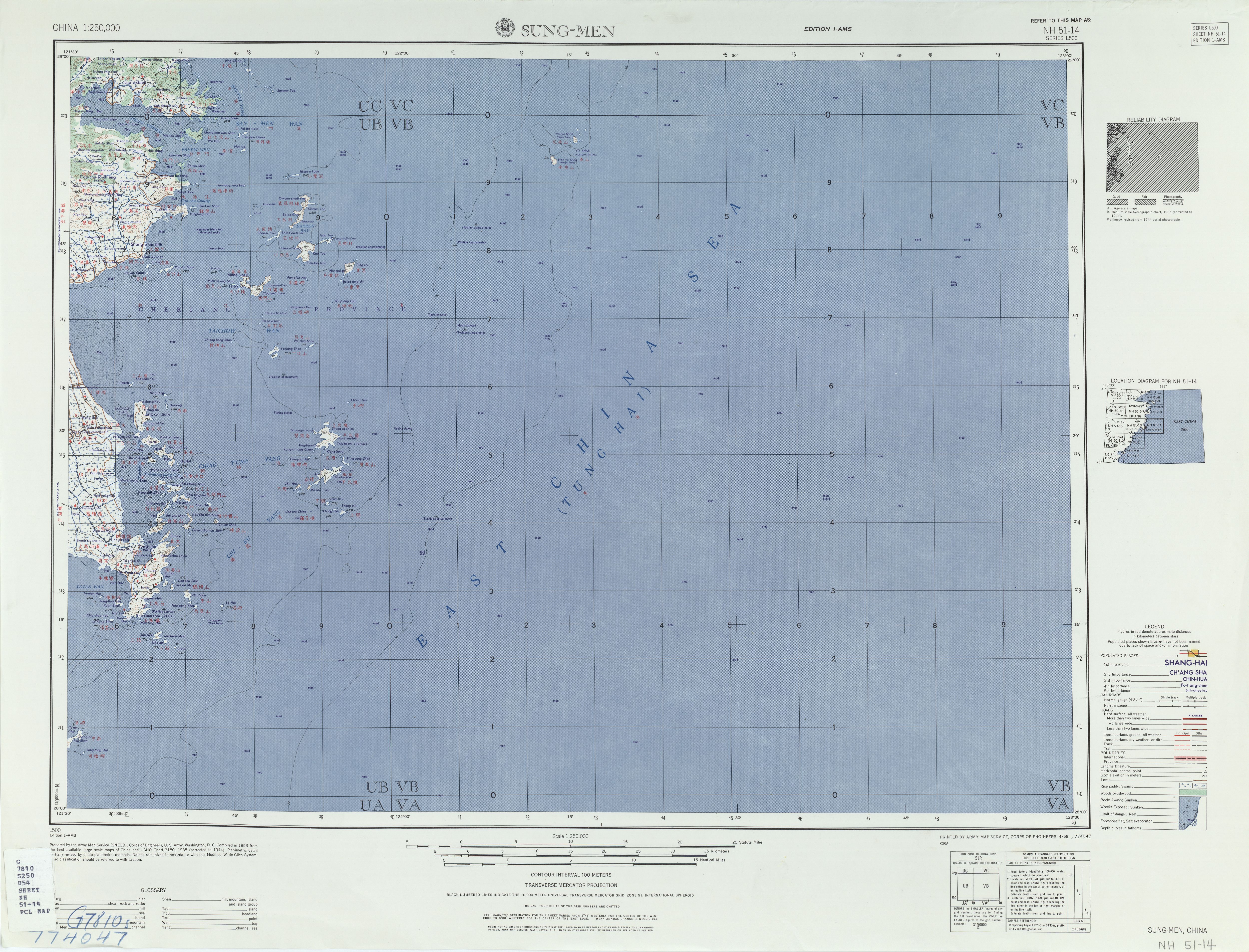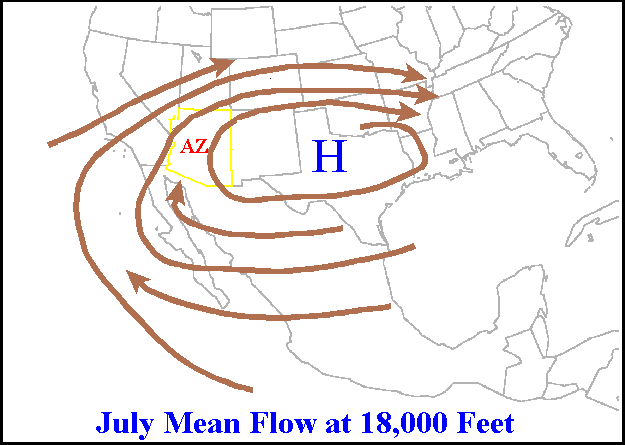|
Typhoon Rananim
Typhoon Rananim, known in the Philippines as Typhoon Karen, was the strongest typhoon to make landfall on the Chinese province of Zhejiang since 1956. It formed on August 6, 2004, intensifying into a tropical storm on August 8. Rananim gradually intensified, initially moving northward before turning to the northwest and attaining typhoon status. After developing a small eye, the typhoon attained peak winds of 150 km/h (90 mph) as it passed between Taiwan and Okinawa. On August 12, Rananim moved ashore in China, and it dissipated three days later. The name Rananim means "hello" in the Chuukese language. Impact outside of China was minimal and largely limited to heavy rains, although one death was reported in Taiwan. In the country, strong winds and heavy rainfall left heavy damage near the coast, as well as to farms further inland. Rananim destroyed 64,300 houses and damaged another 125,000. The typhoon affected 75 counties, affecting 18 mil ... [...More Info...] [...Related Items...] OR: [Wikipedia] [Google] [Baidu] |
Taiwan
Taiwan, officially the Republic of China (ROC), is a country in East Asia, at the junction of the East and South China Seas in the northwestern Pacific Ocean, with the People's Republic of China (PRC) to the northwest, Japan to the northeast, and the Philippines to the south. The territories controlled by the ROC consist of 168 islands, with a combined area of . The main island of Taiwan, also known as ''Formosa'', has an area of , with mountain ranges dominating the eastern two-thirds and plains in the western third, where its highly urbanised population is concentrated. The capital, Taipei, forms along with New Taipei City and Keelung the largest metropolitan area of Taiwan. Other major cities include Taoyuan, Taichung, Tainan, and Kaohsiung. With around 23.9 million inhabitants, Taiwan is among the most densely populated countries in the world. Taiwan has been settled for at least 25,000 years. Ancestors of Taiwanese indigenous peoples settled the island a ... [...More Info...] [...Related Items...] OR: [Wikipedia] [Google] [Baidu] |
Tropical Cyclone
A tropical cyclone is a rapidly rotating storm system characterized by a low-pressure center, a closed low-level atmospheric circulation, strong winds, and a spiral arrangement of thunderstorms that produce heavy rain and squalls. Depending on its location and strength, a tropical cyclone is referred to by different names, including hurricane (), typhoon (), tropical storm, cyclonic storm, tropical depression, or simply cyclone. A hurricane is a strong tropical cyclone that occurs in the Atlantic Ocean or northeastern Pacific Ocean, and a typhoon occurs in the northwestern Pacific Ocean. In the Indian Ocean, South Pacific, or (rarely) South Atlantic, comparable storms are referred to simply as "tropical cyclones", and such storms in the Indian Ocean can also be called "severe cyclonic storms". "Tropical" refers to the geographical origin of these systems, which form almost exclusively over tropical seas. "Cyclone" refers to their winds moving in a circle, whirling ... [...More Info...] [...Related Items...] OR: [Wikipedia] [Google] [Baidu] |
Hunan
Hunan (, ; ) is a landlocked province of the People's Republic of China, part of the South Central China region. Located in the middle reaches of the Yangtze watershed, it borders the province-level divisions of Hubei to the north, Jiangxi to the east, Guangdong and Guangxi to the south, Guizhou to the west and Chongqing to the northwest. Its capital and largest city is Changsha, which also abuts the Xiang River. Hengyang, Zhuzhou, and Yueyang are among its most populous urban cities. With a population of just over 66 million residing in an area of approximately , it is China's 7th most populous province, the fourth most populous among landlocked provinces, the second most populous in South Central China after Guangdong and the most populous province in Central China. It is the largest province in South-Central China and the fourth largest among landlocked provinces and the 10th most extensive province by area. Hunan's nominal GDP was US$ 724 billion (CNY 4.6 tri ... [...More Info...] [...Related Items...] OR: [Wikipedia] [Google] [Baidu] |
Jiangxi
Jiangxi (; ; formerly romanized as Kiangsi or Chianghsi) is a landlocked province in the east of the People's Republic of China. Its major cities include Nanchang and Jiujiang. Spanning from the banks of the Yangtze river in the north into hillier areas in the south and east, it shares a border with Anhui to the north, Zhejiang to the northeast, Fujian to the east, Guangdong to the south, Hunan to the west, and Hubei to the northwest. The name "Jiangxi" is derived from the circuit administrated under the Tang dynasty in 733, Jiangnanxidao (; Gan: Kongnomsitau). The abbreviation for Jiangxi is "" (; Gan: Gōm), for the Gan River which runs across from the south to the north and flows into the Yangtze River. Jiangxi is also alternately called ''Ganpo Dadi'' () which literally means the "Great Land of Gan and Po". After the fall of the Qing dynasty, Jiangxi became one of the earliest bases for the Communists and many peasants were recruited to join the growing people's rev ... [...More Info...] [...Related Items...] OR: [Wikipedia] [Google] [Baidu] |
China Meteorological Administration
The China Meteorological Administration (CMA) is the national weather service of the People's Republic of China. The institution is located in Beijing. History The agency was originally established in December 1949 as the Central Military Commission Meteorological Bureau. It replaced the Central Weather Bureau formed in 1941. In 1994, the CMA was transformed from a subordinate governmental body into one of the public service agencies under the State Council.CMA.gov history Meteorological bureaus are established in 31 , |
Wenling
Wenling ( Wenling dialect: Ueng-ling Zy ; ) is a coastal county-level city in the municipal region of Taizhou, in southeastern Zhejiang province, China. It borders Luqiao and Huangyan to the north, Yuhuan to the south, Yueqing to the west, looks out to the East China Sea to the east. Wenling locates on 28°22'N, 121°21'E, approximately south of Shanghai. Jiangxia Tidal Power Station is located there as well as a number of e-waste recycling centers which have contributed to soil contamination in the region. Because of its geographical location, Wenling has long suffered from typhoons. On August 12, 2004, Typhoon Rananim, the sixth strongest typhoon in PRC history, landed in Shitang Town, Wenling. On 10 August 2019, Typhoon Lekima, the third strongest in PRC history, came ashore at Chengnan Town, Wenling. Administration The county-level city of Wenling currently administers 5 subdistricts and 11 towns. * Taiping Subdistrict (Tha-bing Ka-dau)太平街道 * Chengdong Subd ... [...More Info...] [...Related Items...] OR: [Wikipedia] [Google] [Baidu] |
Coordinated Universal Time
Coordinated Universal Time or UTC is the primary time standard by which the world regulates clocks and time. It is within about one second of mean solar time (such as UT1) at 0° longitude (at the IERS Reference Meridian as the currently used prime meridian) and is not adjusted for daylight saving time. It is effectively a successor to Greenwich Mean Time (GMT). The coordination of time and frequency transmissions around the world began on 1 January 1960. UTC was first officially adopted as CCIR Recommendation 374, ''Standard-Frequency and Time-Signal Emissions'', in 1963, but the official abbreviation of UTC and the official English name of Coordinated Universal Time (along with the French equivalent) were not adopted until 1967. The system has been adjusted several times, including a brief period during which the time-coordination radio signals broadcast both UTC and "Stepped Atomic Time (SAT)" before a new UTC was adopted in 1970 and implemented in 1972. This change ... [...More Info...] [...Related Items...] OR: [Wikipedia] [Google] [Baidu] |
Outflow (meteorology)
Outflow, in meteorology, is air that flows outwards from a storm system. It is associated with ridging, or anticyclonic flow. In the low levels of the troposphere, outflow radiates from thunderstorms in the form of a wedge of rain-cooled air, which is visible as a thin rope-like cloud on weather satellite imagery or a fine line on weather radar imagery. For observers on the ground, a thunderstorm outflow boundary often approaches in otherwise clear skies as a low, thick cloud that brings with it a gust front. Low-level outflow boundaries can disrupt the center of small tropical cyclones. However, outflow aloft is essential for the strengthening of a tropical cyclone. If this outflow is restricted or undercut, the tropical cyclone weakens. If two tropical cyclones are in close proximity, the upper-level outflow from the upwind system can limit the development of the other system. Thunderstorms For thunderstorms, outflow tends to indicate the development of a system. Large qu ... [...More Info...] [...Related Items...] OR: [Wikipedia] [Google] [Baidu] |
Tropical Upper Tropospheric Trough
A tropical upper tropospheric trough (TUTT), also known as the mid-oceanic trough, is a trough situated in the upper-level (at about 200 hPa) tropics. Its formation is usually caused by the intrusion of energy and wind from the mid-latitudes into the tropics. It can also develop from the inverted trough adjacent to an upper level anticyclone. TUTTs are different from mid-latitude troughs in the sense that they are maintained by subsidence warming near the tropopause which balances radiational cooling. When strong, they can present a significant vertical wind shear to the tropics and subdue tropical cyclogenesis. When upper cold lows break off from their base, they tend to retrograde and force the development of, or enhance, surface troughs and tropical waves to their east. Under special circumstances, they can induce thunderstorm activity and lead to the formation of tropical cyclones. Location The TUTT is elongated from east-northeast to west-southwest across oceans of the Nor ... [...More Info...] [...Related Items...] OR: [Wikipedia] [Google] [Baidu] |
Ridge (meteorology)
A ridge or barometric ridge is a term in meteorology describing an elongated area of relatively high atmospheric pressure compared to the surrounding environment, without being a closed circulation. It is associated with an area of maximum anticyclonic curvature of wind flow. The ridge originates in the center of an anticyclone and sandwiched between two low-pressure areas, and the locus of the maximum curvature is called the ''ridge line''. This phenomenon is the opposite of a trough. Description Ridges can be represented in two ways: * On surface weather maps, the pressure isobars form contours where the maximum pressure is found along the axis of the ridge. * In upper-air maps, geopotential height isohypses form similar contours where the maximum defines the ridge. Related weather Given the direction of the winds around an anticyclonic circulation and the fact that weather systems move from west to east: *ahead of an upper-ridge, the airflow that comes from the polar ... [...More Info...] [...Related Items...] OR: [Wikipedia] [Google] [Baidu] |
Luzon
Luzon (; ) is the largest and most populous island in the Philippines. Located in the northern portion of the Philippines archipelago, it is the economic and political center of the nation, being home to the country's capital city, Manila, as well as Quezon City, the country's most populous city. With a population of 64 million , it contains 52.5% of the country's total population and is the fourth most populous island in the world. It is the 15th largest island in the world by land area. ''Luzon'' may also refer to one of the three primary island groups in the country. In this usage, it includes the Luzon mainland, the Batanes and Babuyan groups of islands to the north, Polillo Islands to the east, and the outlying islands of Catanduanes, Marinduque and Mindoro, among others, to the south. The islands of Masbate, Palawan and Romblon are also included, although these three are sometimes grouped with another of the island groups, the Visayas. Etymology The n ... [...More Info...] [...Related Items...] OR: [Wikipedia] [Google] [Baidu] |
Philippines
The Philippines (; fil, Pilipinas, links=no), officially the Republic of the Philippines ( fil, Republika ng Pilipinas, links=no), * bik, Republika kan Filipinas * ceb, Republika sa Pilipinas * cbk, República de Filipinas * hil, Republika sang Filipinas * ibg, Republika nat Filipinas * ilo, Republika ti Filipinas * ivv, Republika nu Filipinas * pam, Republika ning Filipinas * krj, Republika kang Pilipinas * mdh, Republika nu Pilipinas * mrw, Republika a Pilipinas * pag, Republika na Filipinas * xsb, Republika nin Pilipinas * sgd, Republika nan Pilipinas * tgl, Republika ng Pilipinas * tsg, Republika sin Pilipinas * war, Republika han Pilipinas * yka, Republika si Pilipinas In the recognized optional languages of the Philippines: * es, República de las Filipinas * ar, جمهورية الفلبين, Jumhūriyyat al-Filibbīn is an archipelagic state, archipelagic country in Southeast Asia. It is situated in the western Pacific Ocean and consists of aro ... [...More Info...] [...Related Items...] OR: [Wikipedia] [Google] [Baidu] |





